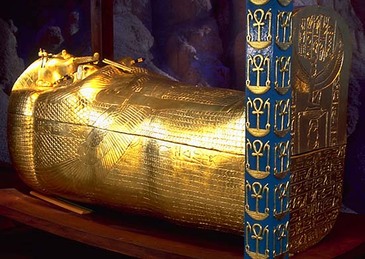Tutankhamun's Death a Murder?
New advances in science have led many historians to believe that King Tut did not die of natural causes, but may have actually been murdered! Historians have identified a number of people who would have gained much from the death of the young pharaoh. In addition, recent examination of Tutankhamun's mummy shows evidence of a wound to the head that may have been fatal.
To begin with, there were many people close to Tutankhamun who may have wanted him dead.
-This includes Aye, Tutankhamun's vizier (advisor). Aye
actually became pharaoh after Tut's death and married his wife!
- Horemhab, the army officer who became pharaoh after Aye's four year rule
is also a prime suspect.
- Additionally, some experts thing that maybe Aye and Horemhab shared the
guilt, working together to kill Tutankhamun and gain his almost unlimited
power.
Both men had many reasons to murder the young king.
- Aye and Horemheb had ruled Egypt while Tutankhamun was a child. It is
easy to believe that, as King Tut grew up, the older men would have been
upset to lose so much power.
- Furthermore, at the time of his death King Tut was old enough to have
children who would inherit his throne. Having children would have eliminated
both men from ever becoming pharaoh, so maybe they realized that if they
planned on murdering Tut, it needed to be soon.
- When Horemhab became pharaoh, he took many of Tutankhamun's
possessions, erased Tut's name and replaced it with his own. Does this sound
like a completely innocent man?
Physical Evidence was discovered when examining the mummy
-An X-ray of Tut's mummy revealed that he may have died from a blow to the
back of his head. The specialist stated, "The blow was to a protected area at
the back of the head that you cannot injure by accident. Someone had to
sneak up from behind and strike."
- X-rays also showed a thickening of bone in the skull which could only occur
after a buildup of blood, which means he may have been left bleeding for a
long time before he died. These scientists believe that the king was most
probably hit on the back of his head while asleep and that he may have lived
for as long as two months before he died.
So, although there is no complete evidence that King Tut was murdered, there were certainly many people that had reasons to want him gone. That, combined with evidence of a fatal blow to the back of the head makes a believeable case that King Tut was murdered by one of his advisors who desperately wanted to possess the might power of the pharaoh.
To begin with, there were many people close to Tutankhamun who may have wanted him dead.
-This includes Aye, Tutankhamun's vizier (advisor). Aye
actually became pharaoh after Tut's death and married his wife!
- Horemhab, the army officer who became pharaoh after Aye's four year rule
is also a prime suspect.
- Additionally, some experts thing that maybe Aye and Horemhab shared the
guilt, working together to kill Tutankhamun and gain his almost unlimited
power.
Both men had many reasons to murder the young king.
- Aye and Horemheb had ruled Egypt while Tutankhamun was a child. It is
easy to believe that, as King Tut grew up, the older men would have been
upset to lose so much power.
- Furthermore, at the time of his death King Tut was old enough to have
children who would inherit his throne. Having children would have eliminated
both men from ever becoming pharaoh, so maybe they realized that if they
planned on murdering Tut, it needed to be soon.
- When Horemhab became pharaoh, he took many of Tutankhamun's
possessions, erased Tut's name and replaced it with his own. Does this sound
like a completely innocent man?
Physical Evidence was discovered when examining the mummy
-An X-ray of Tut's mummy revealed that he may have died from a blow to the
back of his head. The specialist stated, "The blow was to a protected area at
the back of the head that you cannot injure by accident. Someone had to
sneak up from behind and strike."
- X-rays also showed a thickening of bone in the skull which could only occur
after a buildup of blood, which means he may have been left bleeding for a
long time before he died. These scientists believe that the king was most
probably hit on the back of his head while asleep and that he may have lived
for as long as two months before he died.
So, although there is no complete evidence that King Tut was murdered, there were certainly many people that had reasons to want him gone. That, combined with evidence of a fatal blow to the back of the head makes a believeable case that King Tut was murdered by one of his advisors who desperately wanted to possess the might power of the pharaoh.

